Potential Due to Charged Shell
Description:
To find Potential due to a shell of charge ( where the charge will always be on the surface), take a shell of charge with total charge on it be ‘q’ and the areal charge density be ‘σ’. Let R be the radius of the shell. We need to calculate potential due to a conducting shell at point ‘P’.
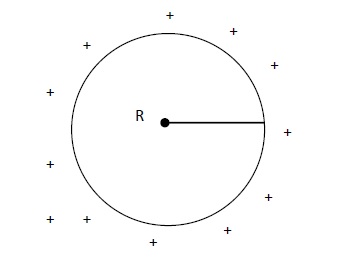
Total Charge = q
Area Charge Density = σ
Divide the location into 3 classes −
- If the point is outside the sphere
- if the point is on the surface of the sphere
- If the point is inside the sphere
Case 1
Let the point ‘p’ be outside the charged shell at a distance ‘r’ from its centre and we need to find Potential at that point.
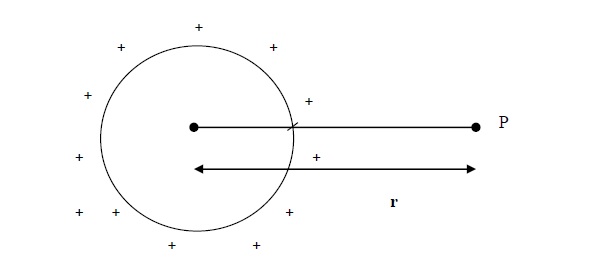
Ɣ>R, V Outside = q4πε0.Ɣ
We know that the Electric field at point outside the shell of charge is −
Eoutside = 14πε0 qr2
We also know the relation between electric field (E) and potential (dV)
- dVdr = 14πε0 qr2
dV = -1 14πε0 qr2dr
Integrating both sides of the equation we get,
∫dV = - 14πε0q ∫ r-2dr
V = - 14πε0q r-1-1
V = 14πε0q r-1
Voutside = 14πε0 qr.....(1)
Note
- So potential at a point outside the sphere behaves like if all the charges are placed at the centre.
- The potential goes on increasing As the distance ‘r’ decrease.
Case 2
Let the point ‘p’ be on the surface of the charged shell at a distance ‘r=R’ and we need to find Potential at P.
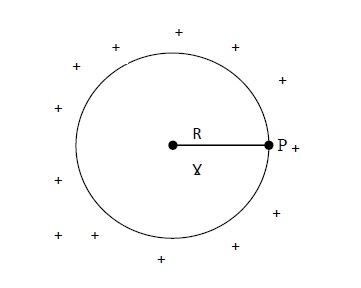
Ɣ = R, V surface = 14πε0 qR
Putting r = R in equation (1) we get,
Vsurface = 14πε0 qR
Note
Potential on the surface is maximum
Case 3
Let the point ‘p’ be inside the charged shell at a distance ‘r’ from its centre and we need to find Potential at P.
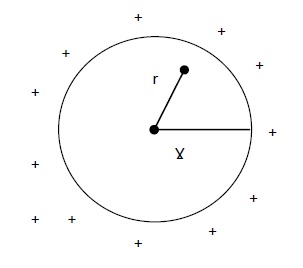
Ɣ
We know that the Electric field at point inside the shell of charge is Zero.
E = - dVdr
But E = 0 inside the shell.
Therefore, - dVdr = 0
⇒ dV = 0
⇒ V = Constant
Note
V is constant inside the shell.
To calculate the value of the potential inside the shell of charge, take two points ( A, B ) on either side of the surface. Let the distance between the points tends to zero, denoted by ‘dr’.
Since, Work done = F * displacement, And as displacement tends to zero, so work done for a charge to move from A to B will also be zero.
But we know that, the work done to bring a unit charge from infinity to a point ‘A’ on the surface is
W = 14πε0 qR2
Similarly, if the charge is taken from infinity to B which is inside the surface , same amount of work will be done on the charge, as the distance between points A and B is negligible.
So, Vinside = Vsurface + 0
Vinside = 14πε0 qR
So the value of Potential inside the shell Vinside = 14πε0 qR
Note
The potential inside the shell is same at every point.
V-R Graph of shell of charge
Diagram
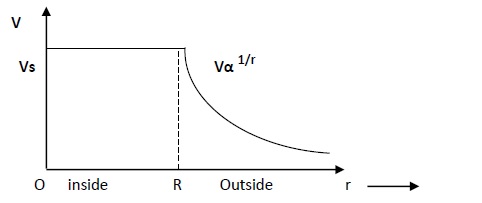
Potential due to charged shell
We know that potential at a point keeps on changing as we move from centre to infinity in case of a spherical shell. To study the relation between potential and the distance graphically, we take help of 3 derived relations −
1. Outside the shell V = 14πε0 qR
2. Inside the shell V = 14πε0 qR
3. On the surface of the shel E = 14πε0 qR
In graph X axis represents the distance (r) from the centre of the shell and Y axis represents potential at point P (V ).
- Point ‘O’ is the origin and represents the centre of the charged shell.
- In X axis, we take a point ‘R’ such that the distance OR represents the radial distance of the shell.
- Right side of point R, represents the outer surface of the shell.
- Potential( V) in Y axis can go upto a certain maximum value.
We know that, inside the shell, potential is always constant (from eq 2) and is equal to potential at the surface. The potential on the surface is always maximum (Vmax) and so inside the shell .So the straight line parallel to X axis represents potential inside and on the surface of the shell.
As we move outside the shell, the potential goes on decreasing with the increase in distance (r) (from eq1 , V ∝ 1/r). Represented by a falling exponential curve.

